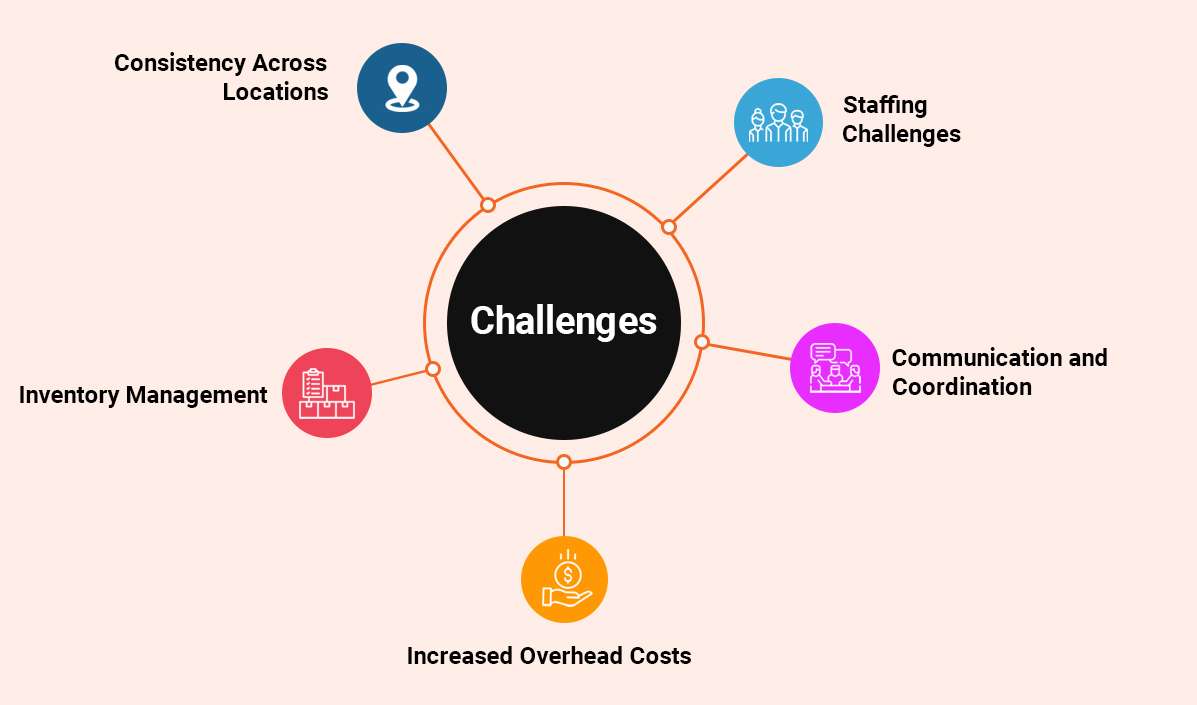Running a restaurant with a single location is a challenging and rewarding experience, but when it comes to managing multiple locations, the stakes get higher. Running a restaurant chain requires an entirely different set of skills and strategies. While it can be incredibly lucrative, it also comes with several unique challenges.
From ensuring consistency across all locations to managing inventory and staffing, there are several obstacles to navigate. In this blog post, we’ll explore some of the biggest challenges of running a restaurant with multiple locations and discuss strategies for overcoming them.
Consistency Across Locations
One of the biggest challenges of running a restaurant with multiple locations is ensuring consistency across all locations. Customers expect the same quality of food, service, and overall experience regardless of which location they visit. This means that every location needs to follow the same recipes, procedures, and customer service standards. Achieving consistency requires effective communication and training across all locations.
Ensuring consistency across all restaurant locations is crucial to maintaining a strong brand reputation and providing a positive customer experience. To achieve this, there are several strategies that restaurant owners and managers can employ:
1. Standardize recipes and procedures
It’s important to establish standard recipes and procedures for all menu items and train staff at every location on how to follow them consistently. This includes everything from the ingredients used to the cooking methods and presentation.
2. Develop a training program
Consistent training for all staff is key to ensuring that everyone is on the same page. Create a comprehensive training program that covers everything from food preparation to customer service, and make sure that every new employee goes through the same training process.
3. Use technology
Technology can be a valuable tool for maintaining consistency across locations. Implementing a centralized point of sale (POS) system can help streamline operations and ensure that all locations use the same menu, pricing, and promotions.
4. Conduct regular audits
Regular audits of each location can help identify areas where consistency is lacking. Use the results of these audits to make improvements and ensure that all locations meet the same standards.
Staffing Challenges
Hiring and retaining good staff is a challenge for any restaurant, but it becomes even more difficult when you have multiple locations. Each location requires its own staff, and it can be tough to find and retain good employees in different areas. It’s important to have a clear hiring process and employee training program that can be replicated across all locations.
Staffing is a critical aspect of running a restaurant with multiple locations, and finding and retaining good employees can be a challenge. Here are some solutions to overcome staffing challenges:
1. Develop a clear hiring process
Establish a clear and standardized hiring process that is consistent across all locations. This process should include job descriptions, job postings, application screening criteria, and interview questions.
2. Create a strong employer brand
Develop a strong employer brand that showcases your restaurant’s values and culture. This can help attract candidates who align with your restaurant’s mission and are excited to be a part of your team.
3. Offer competitive compensation and benefits
Offer competitive compensation and benefits packages to attract and retain top talent. This includes health insurance, paid time off, and opportunities for advancement.
4. Provide ongoing training and development
Implement a training and development program that includes ongoing education and career development opportunities. This can help improve employee retention and job satisfaction.
Inventory Management
Managing inventory is already a challenging aspect of running a restaurant, and it becomes even more complicated with multiple locations. Each location has its own inventory needs, and it can be difficult to keep track of inventory levels and ordering across all locations. Implementing a centralized inventory management system can help streamline the process and prevent issues like over or understocking.
Managing inventory across multiple restaurant locations can be a complex task. Here are some solutions that can help overcome inventory management challenges:
1. Implement a centralized inventory management system
A centralized inventory management system can help streamline the process of ordering and tracking inventory across all locations. This system should allow managers to monitor inventory levels, set reorder points, and generate automated orders when inventory falls below a certain level.
2. Standardize inventory practices
Standardize inventory practices across all locations to ensure consistency. This includes everything from the types of products stocked to how they are stored and counted.
3. Conduct regular inventory audits
Regular inventory audits can help identify discrepancies between inventory levels and actual stock. Use these audits to make adjustments and improve accuracy.
4. Utilize technology
Use technology to simplify inventory management tasks, such as barcoding and scanning inventory items, to automate tracking and reduce errors.

5 techniques for Effective Restaurant Inventory Management
Communication and Coordination
With multiple locations, communication and coordination become key. Managers need to be able to communicate effectively with each other, as well as with staff at each location. This includes regular meetings, clear communication channels, and the ability to quickly share important information.
Communication and coordination are critical for the success of any restaurant, and it becomes even more important when managing multiple locations. Here are some solutions to help overcome communication and coordination challenges:
1. Establish clear communication channels
Establish clear communication channels across all locations. This can include email, phone, instant messaging, or project management software. Make sure that all managers and employees have access to these channels and are trained on how to use them effectively.
2. Schedule regular meetings
Schedule regular meetings between managers at each location to discuss progress, challenges, and upcoming events. These meetings can be in-person or virtual and can be held weekly, bi-weekly, or monthly.
3. Use technology
Use technology to streamline communication and coordination tasks. This includes software for scheduling, project management, and internal communication.
4. Create a communication plan
Create a communication plan that outlines the frequency and methods of communication between managers and employees. This plan should also include protocols for emergency situations.
Increased Overhead Costs
Running multiple locations means increased overhead costs, including rent, utilities, and staffing. It’s important to factor in these costs when planning budgets and making financial decisions. It’s also important to regularly review expenses and find ways to reduce costs where possible.
Managing overhead costs is essential for the success of any restaurant, and it becomes even more important when managing multiple locations. Here are some solutions to help overcome the challenge of increased overhead costs:
1. Create a budget
Create a budget that includes all expenses for each location. This should include rent, utilities, staffing, inventory, and other overhead costs. Ensure that the budget is realistic and allows for some flexibility in case of unexpected expenses.
2. Monitor expenses
Monitor expenses regularly to ensure that they are in line with the budget. Use accounting software to track expenses and identify areas where costs can be reduced.
3. Reduce utility costs
Reduce utility costs by implementing energy-efficient practices. This can include using LED light bulbs, installing energy-efficient appliances, and reducing water usage.
4. Implement inventory management practices
Implement inventory management practices to reduce waste and prevent overstocking. This can help reduce inventory costs and improve cash flow.

Conclusion
Running a restaurant with multiple locations poses numerous challenges that require careful management and coordination to overcome. These challenges include maintaining consistent quality, managing supply chain logistics, and ensuring effective communication and collaboration between locations.
However, with the right strategies and systems in place, restaurant owners can successfully navigate these challenges and achieve success across all their locations. It requires a clear vision, strong leadership, and a commitment to excellence to ensure the long-term sustainability of the business.





